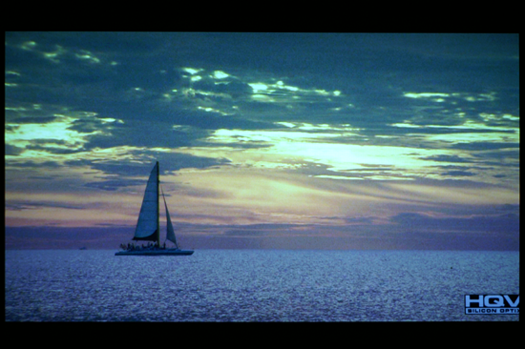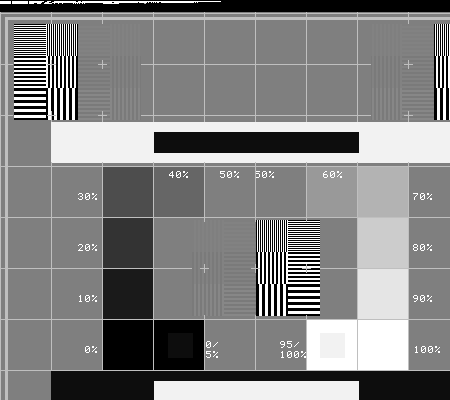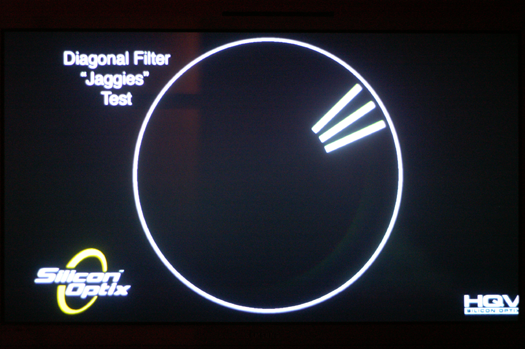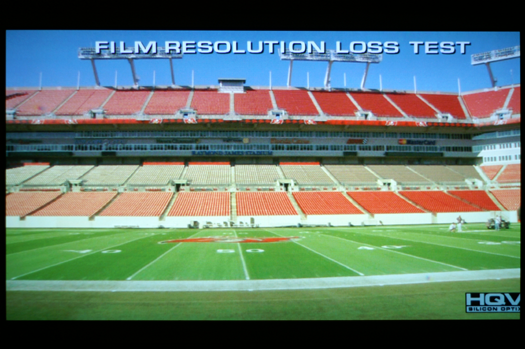Coming Soon to HD DVD: Silicon Optix HD HQV
by Derek Wilson on February 8, 2007 1:25 AM EST- Posted in
- GPUs
The HD HQV Tests
The version of HQV Silicon Optix provided for us contains tests for a couple different aspects of HD video decoding: noise reduction, resolution loss, and deinterlacing artifacts (jaggies). We will break down the specifics of each test and talk about what we are looking for. This time around, Silicon Optix's scoring system is broken down with more variability in each test, but we will try to be as objective as possible in our analysis.
Noise Reduction
The first test in the suite is the noise reduction test which is broken down into two parts. Initially, we have an image of a flower that shows large blocks of nearly solid color without much motion. This tests the ability of the video processor to remove spatial noise.

When no noise reduction is applied, we see some static or sparking in the flower and background. Hardware will score higher the more noise it is able to eliminate without introducing any artifacts into the image.
The second test that looks at noise reduction presents us with a scene in motion. It is more difficult to eliminate noise while keeping objects in motion crisp and clear. In this test, we are looking for noise reduction as well as a lack of blurring on the ship.

Scoring for these tests ranges from 0 to 25, with the highest score going to hardware that is able to reduce noise while maintaining a clear image that has no artifacts. While Silicon Optix has stated that scores can range anywhere from 0 to 25, they break down four suggested scores to use as a guide. Here's the breakdown:
25 - The level of noise is noticeably reduced without loss of detail
15 - The level of noise is somewhat reduced and detail is preserved
7 - The level of noise is somewhat reduced but detail is lost
0 - There is no apparent reduction in noise and/or image detail is significantly reduced or artifacts are introduced.
Until we have a better feel for the tests and the variability between hardware, we will stick with only using these delineations.
Video Resolution Loss
After noise reduction, we look at video resolution loss. Resolution loss can occur as a result of deinterlacing, and effectively reduces the amount of information that is displayed. In interlaced HD video, alternating fields display odd and even scanlines of one image. Simple deinterlacing techniques can choose to simply duplicate the data in the first field and toss out the rest of the information, and others will simply average the data in two fields together to create a frame. Both of these techniques have issues that cause artifacts, and both remove detail from the image.
When objects are not in motion, interlaced fields can simply be combined into one frame with no issue, and good hardware should be able to detect whether anything is moving or not and perform the appropriate deinterlacing method. In order to test the ability of hardware to accurately reproduce material from interlaced video in motion, Silicon Optix has included an SMPTE test image at 1920x1080 with a spinning bar over top to force hardware to employ the type of deinterlacing it would use when motion is detected. In the top and bottom left corners of the SMPTE test pattern are boxes that have alternating black and white horizontal lines that are one pixel wide. A high quality deinterlacing algorithm will be able to reproduce these very fine lines, and it is these that we are looking for in our test pattern.
Interestingly, AMD, NVIDIA, and PowerDVD software all fail to adequately reproduce the SMPTE resolution chart. We'll have to show a lower resolution example based on a smaller 512x512 version of the chart, but our comments apply to the full resolution results.

If the hardware averages the interlaced fields, the fine lines will be displayed as a grey block, while if data is thrown out, the block will be either solid black or solid white (depending on which field is left out).
Scoring for this test is an all or nothing 25 or 0 - either the hardware loses resolution or it does not.
Jaggies
A good deinterlacing algorithm should be able to avoid aliasing in diagonal lines apparent in less sophisticated techniques. This test returns from the original standard definition HQV test, and is a good judge of how well hardware is able to handle diagonal lines of varying slope.

Here we want each of the three lines to maintain smoothness while moving back and forth around part of the circle. Scoring is based on a sliding scale between 0 and 20 with suggested breakdowns based on which bars maintain smooth edges. We will again be sticking with a score that matches the suggested options Silicon Optix provides rather than picking numbers in between these values.
20 - All three bars have smooth edges at all times
10 - The top two bars have smooth edges, but the bottom bar does not
5 - Only the top bar has a smooth edge
0 - None of the bars have smooth edges
Film Resolution Loss
This test is nearly the same as the video resolution loss test, and the score breakdown is the same: 25 if it works or 0 if it does not. This time around, interlaced video of the SMPTE test pattern is generated using a telecine process to produce 1080i video at 60 fps from a 24 fps progressive source. Because of the difference in frame rates between video and film, a 3:2 cadence must be used where one frame of film is stretched across 3 interlaced fields and the next frame of film is stretched across 2 fields.
One major advantage of this process is that it is reversible, meaning that less guess work needs to go into properly deinterlacing video produced from a film source. The process of reversing this 3:2 pulldown is called inverse telecine, and can be employed very effectively to produce a progressive image from interlaced media. If this is done correctly, no resolution needs to be lost.
Rather than having a moving bar over top of the test pattern, the image shifts back and forth from left to right and resolution loss can make the image appear to strobe or produce the appearance of vertical lines along the edges of fine lines.
Film Resolution Loss - Stadium Test
The final test is a practical test of film resolution loss, showing what can happen when a film source is not accurately reproduced. In this case, flickering in the stadiums or a moiré pattern can become apparent.

Scoring for this test is another all or nothing score granting the video decoder being tested either a 10 or a 0.
Now that we've gotten familiar with these tests, let's take a look at how AMD and NVIDIA stack up under HD HQV.
The version of HQV Silicon Optix provided for us contains tests for a couple different aspects of HD video decoding: noise reduction, resolution loss, and deinterlacing artifacts (jaggies). We will break down the specifics of each test and talk about what we are looking for. This time around, Silicon Optix's scoring system is broken down with more variability in each test, but we will try to be as objective as possible in our analysis.
Noise Reduction
The first test in the suite is the noise reduction test which is broken down into two parts. Initially, we have an image of a flower that shows large blocks of nearly solid color without much motion. This tests the ability of the video processor to remove spatial noise.

When no noise reduction is applied, we see some static or sparking in the flower and background. Hardware will score higher the more noise it is able to eliminate without introducing any artifacts into the image.
The second test that looks at noise reduction presents us with a scene in motion. It is more difficult to eliminate noise while keeping objects in motion crisp and clear. In this test, we are looking for noise reduction as well as a lack of blurring on the ship.

Scoring for these tests ranges from 0 to 25, with the highest score going to hardware that is able to reduce noise while maintaining a clear image that has no artifacts. While Silicon Optix has stated that scores can range anywhere from 0 to 25, they break down four suggested scores to use as a guide. Here's the breakdown:
25 - The level of noise is noticeably reduced without loss of detail
15 - The level of noise is somewhat reduced and detail is preserved
7 - The level of noise is somewhat reduced but detail is lost
0 - There is no apparent reduction in noise and/or image detail is significantly reduced or artifacts are introduced.
Until we have a better feel for the tests and the variability between hardware, we will stick with only using these delineations.
Video Resolution Loss
After noise reduction, we look at video resolution loss. Resolution loss can occur as a result of deinterlacing, and effectively reduces the amount of information that is displayed. In interlaced HD video, alternating fields display odd and even scanlines of one image. Simple deinterlacing techniques can choose to simply duplicate the data in the first field and toss out the rest of the information, and others will simply average the data in two fields together to create a frame. Both of these techniques have issues that cause artifacts, and both remove detail from the image.
When objects are not in motion, interlaced fields can simply be combined into one frame with no issue, and good hardware should be able to detect whether anything is moving or not and perform the appropriate deinterlacing method. In order to test the ability of hardware to accurately reproduce material from interlaced video in motion, Silicon Optix has included an SMPTE test image at 1920x1080 with a spinning bar over top to force hardware to employ the type of deinterlacing it would use when motion is detected. In the top and bottom left corners of the SMPTE test pattern are boxes that have alternating black and white horizontal lines that are one pixel wide. A high quality deinterlacing algorithm will be able to reproduce these very fine lines, and it is these that we are looking for in our test pattern.
Interestingly, AMD, NVIDIA, and PowerDVD software all fail to adequately reproduce the SMPTE resolution chart. We'll have to show a lower resolution example based on a smaller 512x512 version of the chart, but our comments apply to the full resolution results.

If the hardware averages the interlaced fields, the fine lines will be displayed as a grey block, while if data is thrown out, the block will be either solid black or solid white (depending on which field is left out).
Scoring for this test is an all or nothing 25 or 0 - either the hardware loses resolution or it does not.
Jaggies
A good deinterlacing algorithm should be able to avoid aliasing in diagonal lines apparent in less sophisticated techniques. This test returns from the original standard definition HQV test, and is a good judge of how well hardware is able to handle diagonal lines of varying slope.

Here we want each of the three lines to maintain smoothness while moving back and forth around part of the circle. Scoring is based on a sliding scale between 0 and 20 with suggested breakdowns based on which bars maintain smooth edges. We will again be sticking with a score that matches the suggested options Silicon Optix provides rather than picking numbers in between these values.
20 - All three bars have smooth edges at all times
10 - The top two bars have smooth edges, but the bottom bar does not
5 - Only the top bar has a smooth edge
0 - None of the bars have smooth edges
Film Resolution Loss
This test is nearly the same as the video resolution loss test, and the score breakdown is the same: 25 if it works or 0 if it does not. This time around, interlaced video of the SMPTE test pattern is generated using a telecine process to produce 1080i video at 60 fps from a 24 fps progressive source. Because of the difference in frame rates between video and film, a 3:2 cadence must be used where one frame of film is stretched across 3 interlaced fields and the next frame of film is stretched across 2 fields.
One major advantage of this process is that it is reversible, meaning that less guess work needs to go into properly deinterlacing video produced from a film source. The process of reversing this 3:2 pulldown is called inverse telecine, and can be employed very effectively to produce a progressive image from interlaced media. If this is done correctly, no resolution needs to be lost.
Rather than having a moving bar over top of the test pattern, the image shifts back and forth from left to right and resolution loss can make the image appear to strobe or produce the appearance of vertical lines along the edges of fine lines.
Film Resolution Loss - Stadium Test
The final test is a practical test of film resolution loss, showing what can happen when a film source is not accurately reproduced. In this case, flickering in the stadiums or a moiré pattern can become apparent.

Scoring for this test is another all or nothing score granting the video decoder being tested either a 10 or a 0.
Now that we've gotten familiar with these tests, let's take a look at how AMD and NVIDIA stack up under HD HQV.










27 Comments
View All Comments
JarredWalton - Thursday, February 8, 2007 - link
*grumble* Should be "we've done HQV...."ShizNet - Friday, February 9, 2007 - link
big part of GPU driver problems are backwards compatibility [GF2-7, Rad.7-X1, DX6-9..];DirectX is totally new beast - why not draw the line and develop drivers from now on for Legacy devices and DX10+ ones?
this will keep old and new drivers in 'good' shape and there's no need for over bloated size files with old junk.
Wwhat - Sunday, February 11, 2007 - link
Since DX10 is vista-only and vista uses a whole new drivermodel it is obvious and inevitable that there are separate drivers developed for post-DX10 heh.So why are you asking for something that everybody already knows is going on and sees happening? Have you not heard about the issues concerning vista and the issues the graphics companies have/had releasing drivers for it?
Plus since ATI-nay-AMD has lots of X1- cards only stuff, it's clear that they also separated their drivers in that sense already.
kilkennycat - Thursday, February 8, 2007 - link
I'm sure that Silicon Optix would only be too happy to quickly develop a hardware HDTV silicon-solution for nVidia and ATi/AMD or their board-partners as manufacturing-option for their graphics cards.. No doubt Silicon Optix developed the HD-HQV tests both to weed out the under-performers AND encourage the widest possible use of their silicon......... Would save nVidia and ATi the bother of even more driver-complication and possible tweaks to their GPU hardware (for mucho, mucho $$) for the few that want the highest-quality HD replication ( regardless of whether the source is 1080p or 1080i or even 720p) from their PCs... The same few would probably be only too willing to shell out the $50 extra or so for the "High-quality-HD" Option-version of their favorite video card.abhaxus - Thursday, February 8, 2007 - link
I use either VLC or DScalar to watch 1080i on my PC. I've got an X800XL so I don't have the ability to use avivo. Would be interested to see how this disc fairs on those two solutions, I've always liked VLC's X method deinterlacing.RamarC - Thursday, February 8, 2007 - link
The testing seemed to focus on de-interlacing issues. HD DVD (and Blu-Ray) are intended to store progressive (non-interlaced) content. Some early titles (and crappy transfers) may be stored as 1080i, but by the middle of this year, 95%+ off all HD titles will be 1080p and de-interlacing will be non-issue.ShizNet - Thursday, February 8, 2007 - link
why focus on interlaced content?______________________________________
can you say TV-broadcasting?
same 95%+ of 'stuff' you'll be watching is TV/Cable/Dish [which are 1080i] and not [HD]DVDs nor IPTV for next 5 years+
even when all TV stations will go digital it's only 540p, don't confuse it up w/ HDTV - 720/1080[i/p]. only BIG ones with deep pockets will go HDTV full time.
autoboy - Thursday, February 8, 2007 - link
You guys are missing the point of this test. Broadcast TV is almost all 1080i content and deinterlacing is very important. The HD-DVD is simply the source of the benchmark but should be able to test the playback capability of PCs for broadcast HD as well as interlaced HD-DVD if it exists. Playing progressive scan images is easy and the only thing that should affect it is the noise reduction which I don't use because it ussually reduces detail.Still...this article left me with more questions than answers.
What decoder did you use for the ATI and Nvidia Tests? Nvidia purevideo decoder or purevideo HD?
Did you turn on Cadence detection on the ATI and Inverse Telecine on the Nvidia card?
What video cards did you use? You ussually use a 7600GT and x1900pro
What drivers did you use?
What player did you use?
Is this test only for HD-DVD decoders or can you use any mpeg2 decoder which would make this a much more relevant test since 1080i HD-DVD is rare and Broadcast HD is what really matters here.
What codec does the HQV use? Mpeg2? VC-1? H.264? Because most VC-1 and H.264 are progressive scan anyway and Nvidia does not claim to support purevideo with anything but mpeg2.
Did you turn on Noise reduction in the Nividia control panel?
Why does Nvidia claim HD Spacial Temporal Deinterlacing, HD Inverse Telecine, HD Noise Redution, etc in thier documentation but cannot do any of the above in reality? Is this h.264 and not supported?
hubajube - Thursday, February 8, 2007 - link
Well this settles whether or not I build an HTPC for HD movie play. This combined with needing a fast CPU (read expensive) as well as a HDCP capable video card pretty much kills a HTPC in the short term. I'll just get a standalone player for now.cjb110 - Thursday, February 8, 2007 - link
Could you get more hddvd players and push them through this test?!?!Also include the DVD results too, as its no good if it can only do one format correctly.
tbh I think it is pretty atrocious that only recently with the Denon 5910 and the Oppo players that we have a dvd player that actual plays dvd's 'properly'.